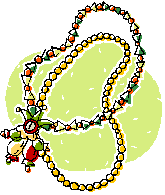



|
A Jewelry Designer's Guide to Gemstone Bead Quality By Adrienne Boerger The first section of this article will briefly introduce the ratings system for diamonds and precious/semi-precious gemstones. The second section will relate this to gemstone bead ratings; how the systems are similar and different and what this means to a designer of handcrafted gemstone jewelry. Diamond and Gemstone Ratings There is a significant, rigid and reliable rating system in place for diamonds and precious gemstones that are sold in the context of fine jewelry. Typical precious gemstones include rubies, sapphires, and emeralds. With respect to diamonds, the ratings system takes into account the four main properties of diamonds that are: 1) Carat, 2) Cut, 3) Color and 4) Clarity. Together these are referred to as the “4 C’s”. Carat refers to the weight/size of the diamond and the cut refers to whether the proportions of the cut stone result in the best sparkle. A colorless diamond gets a higher rating than one with a more yellow color and diamonds with few imperfections or “inclusions” in the stone are rated the best for clarity. These four C’s can indicate the overall value of a diamond. In the case of precious gemstones (rubies, emeralds, and sapphires) and semi-precious (all other colored stones) the rating system is somewhat different. Precious and semi-precious gemstones vary in their “hardness” on a scale from 1-10. The hardness refers to the ability of the gemstone to be scratched by another gemstone of a given hardness. Diamonds are the hardest of all stones. Clarity is also an important factor in properly evaluating precious and semi-precious stones. In the case of translucent gemstones, a lack of inclusions generally translates into a clear, sparkling gemstone, therefore increasing its value. Many inclusions typically result in a “milky” or dull look and likewise decrease a gemstone’s value. Color can also play a factor in gemstone value in that a particular color is more rare, and is often more valuable as a result. For example, garnet comes in several different colors including red, burgundy, green and brown/amber. The green garnet is typically a more expensive gemstone due to its rarity. Gemstone Bead Ratings Beads that are polished, drilled gemstones used for handcrafted jewelry are rated using a similar, but a much simpler and less rigorous system. As described previously, the hardness of a gemstone plays a role in determining the overall value. This applies to gemstone beads as well. Beads are generally rated with a lettering system A-C where a rating of “A” is a higher quality bead than a rating of “C”. This system is often used to rate other types of beads, such as glass crystals as well. In addition to hardness, other features are considered such as color, clarity and also the polish (the quality of the finish). In addition, the quality of the hole drilling is important. Good quality beads will have symmetrical holes and the edges of the holes will also be smooth, not jagged. With respect to size, it is generally true that the larger the bead, the more it costs, however this is not always the case. It can be more difficult to polish many tiny beads, thus some of the smaller beads can actually cost more. Since semi-precious gemstone beads are often sold on temporary strands, another factor that is unique to buying beads is whether or not they are properly matched. The more similar in size the beads are, the better the strand will be rated. Unfortunately, not every bead manufacturer or retailer uses this, already imperfect, system the same way. It is important to keep this in mind when buying beads labeled AA or AAA. Beads that truly qualify for these ratings (and the price!) should have the following features: 1) attractive (or even rare) color, 2) translucent, clarity, 3) shiny, highly polished, 4) smooth symmetrical shape 5) evenly and completely drilled holes, and 5) accurate sizes. There are many beads on the market that are very nice and useful for jewelry making that do not necessarily qualify for an “A” rating. Beads with an “AB” rating or even a “B” rating are abundant on the market, and they serve a useful purpose as spacers or as a small component in jewelry where those beads are not necessarily the focus. The beads may have slightly asymmetrical shapes or a more opaque appearance. In some cases a bead reamer may be necessary to widen a hole that is incomplete. In conclusion, there are many similarities between the rating systems for diamonds, for precious and semi-precious gemstones used for making fine jewelry and the rating system for semi-precious gemstone beads. Many of the same factors are considered, however there is a little less “rigor” in the system when it comes to beads. As long as the beader is aware of the factors, it will be possible to find a reliable source for high quality gemstone beads.
About the
Author:
|
|
|---|
Search the Web: 
Custom Search
|
Contact Us |
|---|